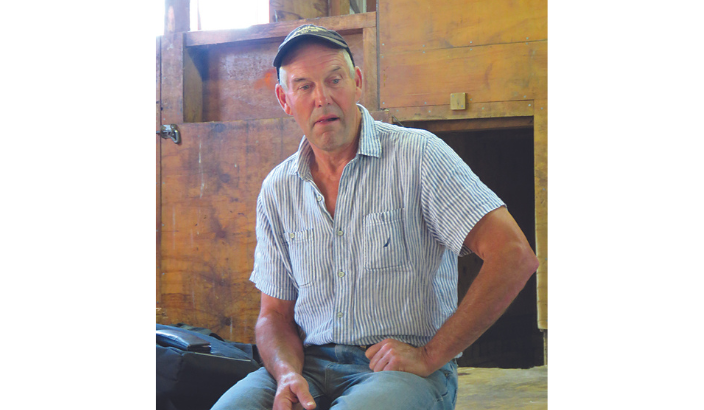A History of Farming in The Sounds Portrayed

Mike Gerard presented the history of farming in the Sounds at the recent Manaroa field day. Photo: Andrew Ritchie.
ANDREW RITCHIE
Mike Gerard presented an overview of the history of farming in the Sounds at the Beef and Lamb Field Day at Manaroa. He admitted to having only been in the area for 50 years but was married to a fifth-generation resident.
Pakeha arrived there in the 1840s settling on land sold by Te Rauparaha to the crown after he had slaughtered most of the native iwi of the area. Access was by row boat primarily and later by steamers and scows. In the late 1800s bridle tracks were created and stock was driven out along these byways.
Ebeneezer Hayes farmed Titirangi Station where he grazed 2000 cows and 10500 ewes during the early 1900s. He used drovers to walk his livestock all the way from the Sounds to Addington in Christchurch. Telephones came to the area in 1903 using the bridle tracks for the lines, thereby connecting the area with the outside world. The advent of refrigerated ships saw the establishment of the Picton works in 1900 and livestock was barged through the Queen Charlotte to the company.
There were 23 suppliers to the Sounds Dairy Society situated in Paradise Bay and milk was collected every second day. “In 1900 a census, which had no reference to gender preference, indicated that there were 170,000 sheep in the Sounds district,“ said Mike. During the depression of the early 1900s a certain amount of depopulation occurred with much of the hill country becoming uneconomic to farm.
Scrub clearance with fires initially provided fertiliser to the hill ground but this slowly ran out and the humus was destroyed. Lime and fertiliser was applied generally by hand to the flats until the Tiger Moths and later the Dc3s took over, spreading from the air and flying from Woodbourne or the airfields in the South of the North Island. In the 1960s the service ceased and fern began to establish. Merinos were brought in to control the fern in some areas. In 1986 Rogernomics arrived and scuttled many plans fostering the planting of pine forests. Since then, Sounds farmers have had to become more efficient rearing more lambs and finishing stock.
Hoggets were mated and heifers were put in calf as yearlings, more lime has been spread and more shelter established to limit lamb loss. The Gerards have gone back to baiscs,milking a house cow, growing their own vegetables, and making their own cheese.
Mike’s father-in-law used to say, “where there is a will there is a way, but be warned living in the Sounds means things will take twice as long, be twice as expensive and twice the amount of work.”
The Gerards farm in Hopai bay where animal health problems include foot rot, high worm counts and ticks. Deer volumes have exploded and they took 150 possums out of their vegetable garden during the year. Freight for livestock from the Sounds costs an extra $4/head for sheep and $12/head for cattle. Ph of the soil is also a problem and carting fertiliser by barge has added substantially since the road closed. Although there is currently a subsidy on barge operations. Fuel supply is also difficult since the floods, 44-gallon drums have to be utilised now and filled from the barge.
“It is like going back 50 years in time,” says Mike. People think of the Sounds as one area but the outer Sounds have higher fertility but less rainfall, so the stocking rate is approximately 10su/ha. The inner Sounds have higher rainfall lower fertility but higher stocking rates at 12-15su/ha.Attendees left with a much greater understanding of the challenges of farming in the Sounds.
